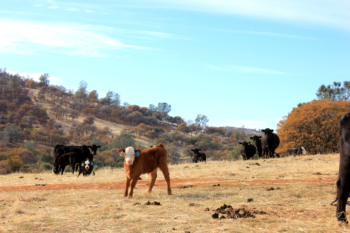UC Blogs
Monarch Sighting, All Day, Every Day
If a picture is worth a thousand words, what is a mural worth? Priceless--if it's a mural of a realistic monarch butterfly, teasing you with a strip...

The mural from a distance. (Photo by Kathy Keatley Garvey)

Moving in closer. (Photo by Kathy Keatley Garvey)
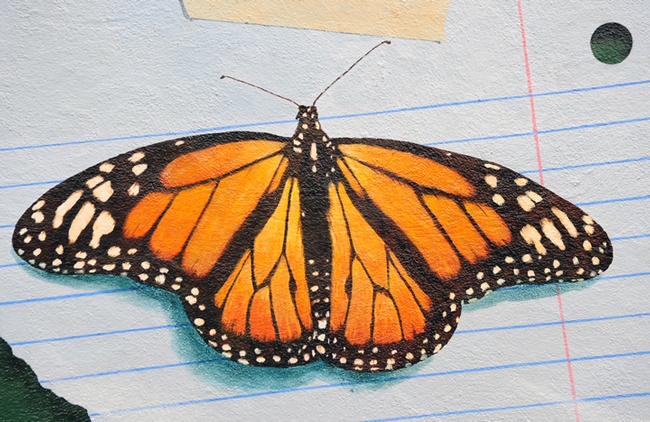
And closer. (Photo by Kathy Keatley Garvey)
National attention for the California drought
California's deepening drought woes were shared with the nation over the weekend in an article by New York Times reporter Adam Nagourney. The story noted efforts by UC Cooperative Extension to help ranchers survive the crisis.
UCCE and the UC Sierra Foothill Research and Extension Center joined forces last week to provide ranchers with information they need to make tough decisions about the future of their cattle. According to the caption of one of the photos in a 10-image slide show accompanying the NY Times story online, four-foot-high grass typically blankets rangeland areas where now only short brown stubble can be found.
Three photos in the slide show were taken during the field portion of the day-long UC workshop on drought survival. They include:
- UC Davis veterinarian Nancy Martin speaking to ranchers about keeping herds healthy
- Browns Valley rancher Terry Stevens
- Cattle ranchers examining an alternative type of feed
The Times story also quoted Jeremy James, director of the Sierra Foothill REC.
“We have people coming from six or seven hours away,” he said. More than 100 ranchers attended the event.
In addition, the Browns Valley workshop was webcast live to seven locations around the state where ranchers gathered at UC and farm bureau offices, and to dozens of individuals. One of the individuals was Tim Hearden of Capital Press. He followed up with a 600-word article containing pertinent advice from UC Cooperative Extension to concerned ranchers. A key point he reported came from Roger Ingram, UC Cooperative Extension advisor in Placer and Nevada counties.
“Number one, never try to feed yourself out of a drought,” Ingram said. “It can bankrupt you financially and … it can bankrupt you ecologically."
Other important points from UCCE mentioned in the article were:
Consider weaning early to boost cows' efficiency. A cow that stops feeding sees a spike in energy to prepare for the next calving season. - Josh Davy, UCCE advisor in Tehama, Colusa and Butte counties
Producers with limited water should remember that irrigated pasture is thirstiest during the summer and not as much in the fall. - Larry Forero, UCCE county director in Shasta County
Younger cow-calf operators should seek advice from those who made it through the last catastrophic drought in the mid-1970s. - Glenn Nader, UCCE advisor in Yuba, Sutter and Butte counties
Bok Tower and Gardens
On a recent trip this past summer to visit my daughter in Tampa, Florida, I had the opportunity to visit the “Bok Tower and Gardens”. I had never heard of these gardens and what I found was a wonderful surprise!
Bok Tower and Gardens located in Lake Wales, Florida is about 60 miles east of Tampa. The gardens consist of 7.5 acres of meandering, contemplative and informal woodland settings offering a series of romantic recesses and tranquil resting spots, picturesque vistas and breathing taking views of the “Singing Tower”. The gardens are considered one of the greatest works of famed landscape architect Frederick Law Olmsted Jr., son of the senior Olmstead who designed central park in New York City.
The gardens house two remarkable features: the “Singing Tower” and the “Pinewood Estate”. The idea for the Singing Tower and the gardens surrounding it was the vision of Edward William Bok (1863-1930). Mr. Bok, an American editor and Pulitzer Prize-winning author, was born in Den Helder, Netherlands. He came to the United States at the age of six. He worked for several publishing companies, was editor of “The Brooklyn Magazine” from 1884 to 1887. In 1886, he founded “The Bok Syndicate Press”, which led to the editorship of “The Ladies Home Journal in 1889. Under his leadership the Journal became one of the most successful and influential publications in America and the first magazine in the world to have one million subscribers.
In 1921, Mr. Bok had an idea to preserve the hilltop outside of Lake Wales known as “Iron Mountain”, located at 298 feet above sea level. His idea was to preserve the hilltop and create a bird sanctuary; a place of beauty, serenity and peace. Mr. Olmstead directed the installation of the gardens with the first year devoted to the digging of many trenches and the installation of irrigation piping. Next the installation of many thousands of loads of rich black soil and lastly the plants. Today the gardens boost a fantastic display of ferns, palms, oaks, pines, azaleas, camellias, magnolias, and a large array of flowering plants. The gardens also play host to 126 different species of birds, as well as the threatened gopher tortoise and endangered eastern indigo snake. The gardens took 5 years to complete.
Located within the garden is “Singing Tower”, a 60 bell carillon. The sixty bells range in size from 16 pounds to nearly 12 tons. The bells do not move, instead, the clappers inside strike the bells to produce a considerable range of sounds up to five or six octaves. Bok's carillon was designed and built in 1928. The bells are housed in a 205 foot tall neo-Gothic and art deco tower designed by famed architect Milton B Medary and ornately crafted by noted stone sculptor Lew Lawrie.
The other hidden gem with the gardens is “Pinewood Estate”, a beautiful 20 room Mediterranean style mansion. The mansion was built within the 7.5 acre garden in early 1930 for Charles Austin Buck, a Bethlehem steel vice president. In 1970, the daughter-in-law of Edward William Bok acquired the mansion that is now part of the Bok Tower Gardens.
On February 1, 1929, President Calvin Coolidge dedicated the gardens in Lake Wales, Florida, which Mr. Bok had made as a gift for visitation by the American people in gratitude for the opportunity they had given him. Edward William Bok died at Lake Wales within sight of his beloved “Singing Tower” on January 9, 1930, and is buried at the base of the tower.
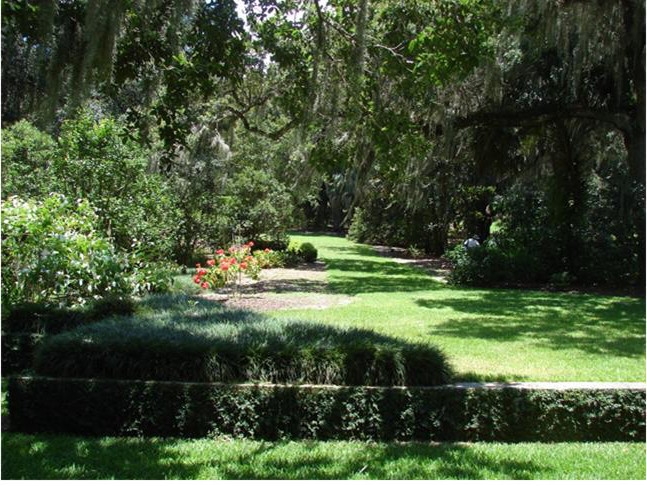
The beautiful scenery at Bok Tower Garden. (photos by Ken Williams)
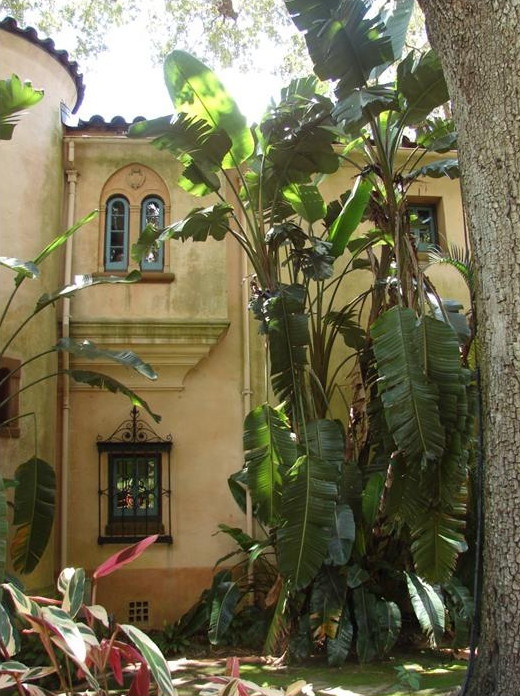
bok 2
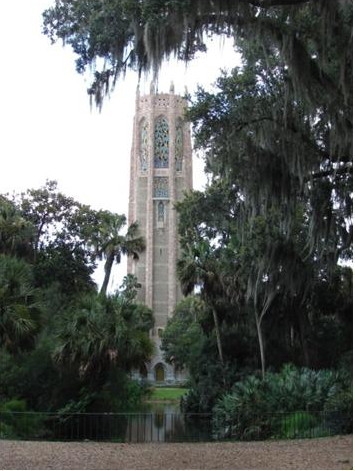
Singing Tower
Exporting water through hay – Further Twists and Turns
For those of you who have followed the controversy about the export of ‘virtual water' in the form of hay exported to other countries –...
About that Pollen...
Why is that in a honey bee colony, workers can carry pollen but not the queen? Well, scientists from Michigan State University and Wayne State...
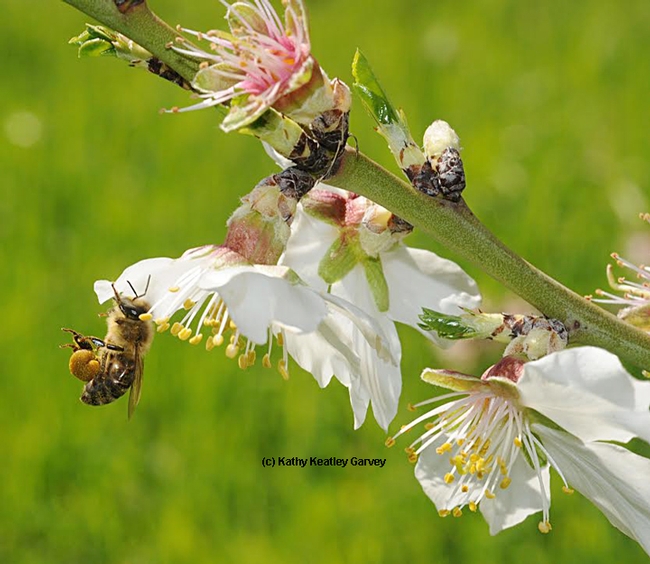
Honey bee packing pollen on an almond tree at UC Davis--on the grounds of the Harry H. Laidlaw Jr. Honey Bee Research Facility-- several years ago. (Photo by Kathy Keatley Garvey)
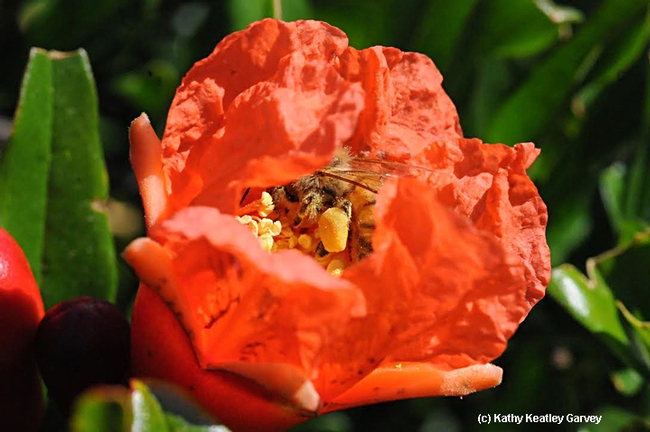
Now that's a load of pollen! Honey bee inside a pomegranate blossom. (Photo by Kathy Keatley Garvey)


